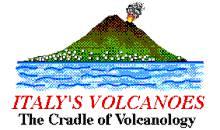|
NEW:
Excursions to the Etna area, For those of you who missed the Etna telecamera (please note that I am not the right person to ask about technical details of the telecamera), visit this site: "Sistema Poseidon" (in Italian) and go to "Etna live-cam "
29
January 2000 update.
On Etna's summit, the SE Crater has erupted again this morning (29
January), producing its second eruptive episode in three days. The
activity was apparently very violent and short-lived: at about 0845
h (local time=GMT+1) Giuseppe Scarpinati, Italian correspondent of
the French "L'Association Volcanologique Européenne"
(L.A.V.E.), saw a spectacular eruption column rising to a height of
several kilometers above the summit; after 0900 h the activity was
already declining. Scarpinati lives in Acireale and has a panoramic
view of the southeastern side of the volcano; at his home loud rumblings
were audible during the activity. Tephra fell over the eastern flank
of the volcano, and therefore the skiing areas on the southern and
northern flanks of Etna luckily were spared: this weekend, with favorable
weather conditions persisting, a massive rush of skiers to the mountain
is expected. 27
January 2000 update.
The SE Crater has apparently calmed after yesterday's spectacular
eruptive episode. Lava effusion continued after nightfall yesterday,
but diminished gradually during the night, and this morning (27 January)
very little incandescence was visible on the new lava flow that has
spilled about 1.5-2 km into the Valle del Bove. When observed before
daybreak from Acireale by Giuseppe Scarpinati, Italian correspondent
of "L'Association Volcanologique Européenne" (L.A.V.E.),
no incandescence was visible at the summit craters of Etna. The new
lava flow has advanced downslope along the southern margin of the
lava flow-field formed during the long-lived effusive activity of
February-November 1999 and reached the floor of the Valle del Bove. 26
January 2000 update.
During the past week (until shortly after midnight on 26 January)
the activity at Etna's summit craters has continued at similar levels
to the previous weeks, with mild Strombolian activity in one of the
eruptive vents of the Bocca Nuova. This activity was accompanied by
frequent ash emissions that were well visible from towns around the
volcano during the few moments of clear weather. 19 January 2000 update. Weather conditions have again worsened today, Etna is again in clouds, and there are probably more snow falls. However, last night the sky was clear, and mild, intermittent Strombolian activity could be seen at the Bocca Nuova. This activity was similar to that observed in early January, but weaker. 18
January 2000 update.
After nine days of very bad weather (which has caused heavy snow falls
on Etna down to about 1000 m elevation), the volcano has become visible
again from Catania this morning. The visible activity consists mostly
of dense gas emission from the Bocca Nuova, accompanied by sporadic
puffs of brownish-gray ash. Most snow on the S flank of the main summit
cone and on the SE Crater cone has melted, indicating heat emission
from the ground. A series of other web pages covering the October-November eruptions of the Bocca Nuova have recently posted; these contain photos and movie clips of some of the most spectacular moments of that period. A photo gallery covering the period September-November 1999 (with photos by Boris Behncke and Giuseppe Scarpinati) Photos of the eruptive activity, 26-31 October 1999, by Tom Pfeiffer (University of Arhus, Denmark) Photos by Marco Fulle, 17-23 October 1999, at Stromboli On-line - Marco at his best Very impressive video clips, taken by Roberto Carniel on 17-23 October 1999, at Stromboli On-line Photos by Juerg Alean, of 1 November 1999, at Stromboli On-line Video clips, taken by Juerg Alean on 1 November 1999, at Stromboli On-line A page by Charles Rivière, France, with many photos of the summer and autumn of 1999 (in French)
Page set up on 27 May 1997, last modified on 29 January 2000 |
||
